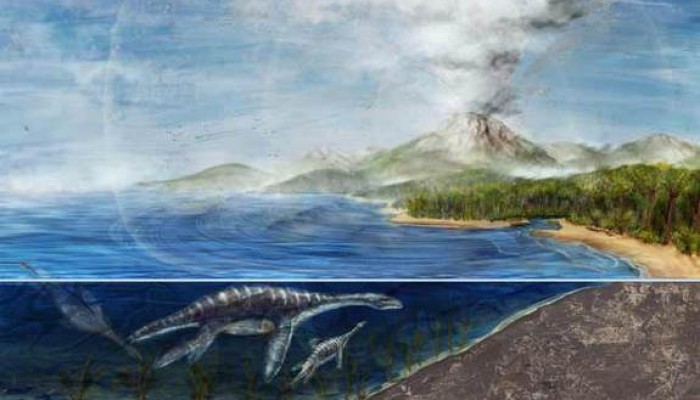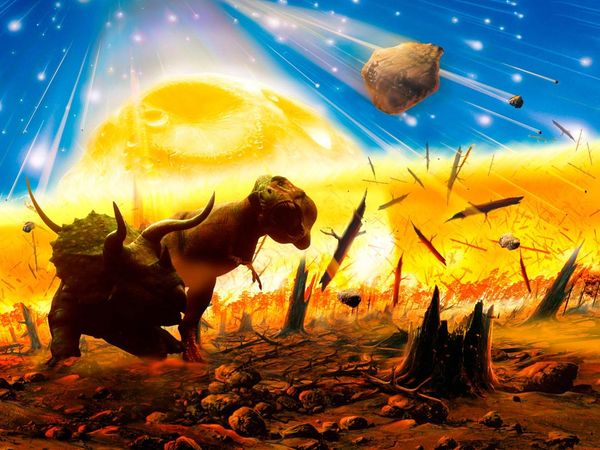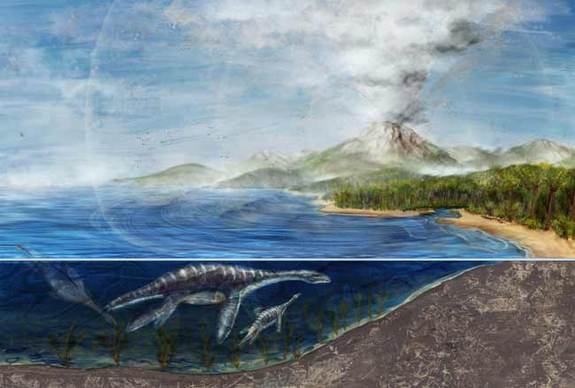
It’s dark. It’s always dark these days. Lights in the sky burn your eyes, so you keep your face to ground in the hopes that they’ll go away. But they don’t. The air is heavy. Heavy with poisons that make it difficult to breathe. Heavy with foreboding dread.
You, my unfortunate friend, are going through a mass extinction!
There have been five periods of mass extinction in the past. These represent major phases in the history of life where we see global reorganisations of ecosystems and their inhabitants.

The usual candidate for the death of the dinosaurs – a catastrophic bolide impact! (source)
Perhaps the most infamous is the end-Cretaceous mass extinction, 66 million years ago. This even saw the extinction of numerous weird and wonderful marine reptile groups, the flying pterosaurs, ammonites, and of course, the non-avian (bird-line) dinosaurs.
Scientifically speaking, we’re in broad agreement about what caused this upheaval of life. A combination of a huge asteroid impact at Chicxulub in Mexico with the massive eruption of the Deccan Traps in western India is thought to have made living more insufferable than spending Christmas with the in-laws.
The question still remains, though, how did each of these contribute to the mass extinction?
One problem for this has been timing. How do we date both events relative to the pace and magnitude of extinction we see from the fossil record?

But perhaps massive volcanism was responsible for extinctions too? (source)
A new team, led by Blair Schoene of Princeton University, has recently provided us some insight to this using radiometric dating of zircon crystals preserved within the ancient Deccan lavas.
What they have shown is that the main Deccan eruptions occurred about one-quarter of a million years before the end of the Cretaceous period, and the onset of the Cenozoic (66 million years ago to now). Over 1.1 million cubic kilometres of basaltic lava erupted through about 753,000 years. That’s quite a lot of lava, and about 80-90% of the total eruption volume from the Deccan meg-volcanism.
To put this in a global historical context, that’s slightly less than the 1.5 million cubic kilometres from the Paraná-Etendeka traps covering much of Africa and South America from the Jurassic/Cretaceous boundary some 80 million years earlier, and a lot less than the 50 million cubic kilometres erupted on the Ontong Java plateau around 120 million years ago. (Not that I’m biased or anything, studying this poorly-researched period of time – more on this soon!) Either way, it’s still a massive heap of volcanic material to spew out.
The precise dating of the Deccan volcanism as before the end of the Cretaceous implies that it, and the environmental impacts the eruption had, almost certainly contributed to the mass extinction event. This is important, a previous calculations of the age of eruptions has huge uncertainty ranges, making it difficult to compare to environmental and biological records from around the same time.
Furthermore, analysis of this material provided a new date for the end of the Cretaceous, at 65.968 million years ago (with 0.085 million years off to either side) – a pretty reliable date, and largely congruent with previous calculations.

“Look mummy, isn’t the volcano pretty!” *sniff* (source)
But what does this mean for extinction mechanisms? A volcanic eruption alone will only affect fauna and flora in the immediate area. It’s the knock on effects off eruptions that can be the most devastating on a much broader, global scale.
Global warming can be caused by the release of greenhouse gases during eruption, much like we see occurring today. These can also cause global cooling though, depending on what gases or materials are released. Breathing would be like taking a hit from a London bus exhaust pipe. By pumping new chemicals out, we can also see effects of acid rain and ocean acidification.
The next step then, to me, is pretty clear. We need to look at the rate and magnitude of eruption through time, as well as create precise timelines for associated environmental changes. By combining this with the biological record of diversity and extinction, we can start to see with real accuracy what the drivers of extinction in different groups of organisms were, from the lowliest foraminifera to the mightiest dinosaur.
Perhaps then, we can use this to help offset the impact of a sixth mass extinction happening right now.
Reference
Schoene, B. et al. (2015) U-Pb chronology of the Deccan Traps and relation to the end-Cretaceous mass extinction, Science, 347, 182-184 (link)

Rick
Seems to me the volcanic eruptions could have been directly or indirectly caused by a meteor impact. Is there a good way to determine which of the two occurred first with any high degree of accuracy?
Jon Tennant
Well, the eruption was in India, and the impact in Mexico, so I guess geography would be a pretty good decider!
Thomas R. Holtz, Jr.
A good way of figuring out which came first is magnetostratigraphy. The impact occurred during a magnetic reversed interval (chron C29r), when the Earth’s magnetic field was the opposite direction of today. (This information is recorded in certain types of igneous and metamorphic rocks).
In contrast, the lowermost layers of the Deccan Traps volcanic flows show a magnetic normal reading, so they must have started before the flip-flop from chron C30n to C29r. This, as well as new radiometric dates, show that the Deccan Traps lava were already eruption tens of thousands of years before the impact happened.
Jon Tennant
There we go! Thanks for the proper, scientific answer, Tom 🙂
Ronald Shimek
How do the Deccan Traps eruptions compare with the Siberian Traps that are implicated in the closing of the door on the Earth’s first diverse life with end Permian extinction.
Pingback: Morsels For The Mind – 06/02/2015 › Six Incredible Things Before Breakfast